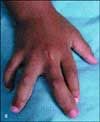- Clinical Technology
- Adult Immunization
- Hepatology
- Pediatric Immunization
- Screening
- Psychiatry
- Allergy
- Women's Health
- Cardiology
- Pediatrics
- Dermatology
- Endocrinology
- Pain Management
- Gastroenterology
- Infectious Disease
- Obesity Medicine
- Rheumatology
- Nephrology
- Neurology
- Pulmonology
Hyperpigmented Macules: Lines of Blaschko
Lines of Blashko may represent normal embryonic movements of the skin during embryogenesis.
There are several disorders of hyperpigmentation that follow the lines of Blaschko--and this distribution can aid in their diagnosis. The lines of Blaschko were originally described by Alfred Blaschko in 1901. He recognized the pattern as distinct from dermatomes and Langer lines. The lines of Blaschko form a "V" shape over the spine, "S" shapes over the lateral and anterior aspects of the trunk, and a linear pattern over the extremities. It is thought that these lines represent normal embryonic movements of the skin during embryogenesis. The manifestation of certain diseases along these lines is believed to represent somatic mosaicism, with abnormal skin surrounded by normal skin clearly showing the distinction. Several of the diseases of hyperpigmentation we present here follow these lines--as evidenced in the following photos.



Pigmentary mosaicism. The patient in Figure A, a 6-month-old girl, demonstrates the phenomenon of pigmentary mosaicism. The areas of hyperpigmentation follow the lines of Blaschko. The phenomenon of pigmentary mosaicism was first described by Ito in 1952. Since that time, there has been an expanding recognition of a group of disorders that affect both sexes in which chromosomal mosaicism is always suspected and frequently demonstrated--albeit sometimes with great difficulty. Case reports and series describe patients with a wide variety of other abnormalities that may involve the hair, teeth, eyes, heart, and CNS. Often patients have no other abnormalities. Disorders of pigmentary mosaicism differ from incontinentia pigmenti in that both sexes are affected, and the pigmentary changes with mosaicism--which may be hyper- or hypopigmentation--are not preceded by vesicular or verrucous lesions as they are in incontinentia pigmenti.
Proteus syndrome. This rare disorder is characterized by overgrowth of multiple tissues in a mosaic pattern. The term "proteus" is derived from the Greek sea god of the same name, who had the ability to appear in the form of any creature to avoid being captured. The same is true of this heterogeneous disorder that can involve the skin, subcutaneous tissue, connective tissue, CNS, and the viscera. The most common clinical manifestations are epidermal pigmented nevi, nevi on the palms and soles, hyperostosis, local gigantism, hemihyperplasia, and multiple lipomas in the subcutaneous tissues and abdominal and pelvic cavities. The nevi typically follow the lines of Blaschko.
Figure B shows an epidermal nevus in the axilla of a 4-year-old girl with this disorder. Figure C demonstrates gigantism of this girl's fingers.
Kymera's Oral STAT6 Degrader KT-621 Shows Biologic-Like Activity in Early Atopic Dermatitis Trial
December 8th 2025KT-621 achieved deep STAT6 degradation and strong 4-week EASI and itch reductions, offering a potential new oral option for moderate–severe AD and other Th2 inflammation-driven disease.
